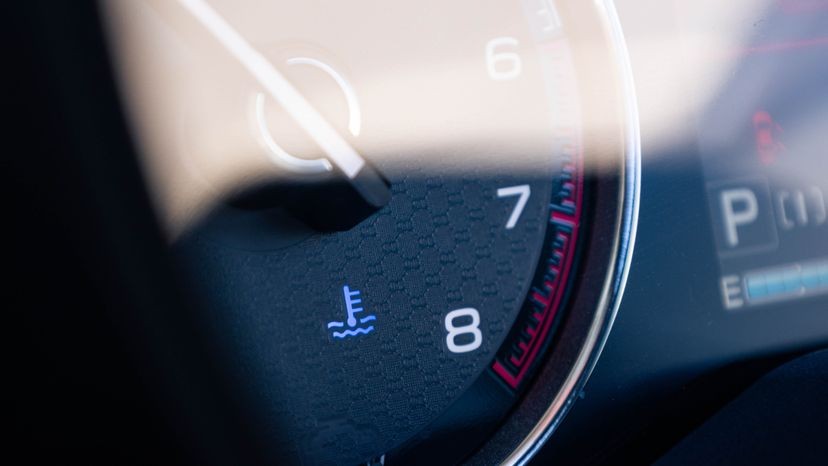Updated: Feb 21, 2024
 Close up of a car
Close up of a car
The thermostat plays a crucial role in engine health by ensuring it warms up quickly, reducing wear and emissions. Jackyenjoyphotography / Getty Images
In the intricate world of automobiles, every component plays a vital role in ensuring optimal performance and longevity. When considering the question, “What Does The Thermostat On A Car Do?”, many might be surprised to learn about its significant contribution.
Designed to meticulously monitor and maintain the engine’s ideal operating temperature, the thermostat, typically around 2 inches (5 cm) in diameter in most vehicles, might seem small. However, this unassuming part is indispensable in preventing your engine from experiencing the detrimental effects of running either too hot or too cold.
Contents
How a Thermostat Works: Regulating Coolant Flow
Every car engine that utilizes liquid cooling is equipped with a thermostat. This device is strategically positioned between the engine block and the radiator, acting as a crucial valve to manage the flow of coolant. Its primary function is to open and close based on specific temperature thresholds.
When you start a cold engine, the thermostat remains closed, effectively blocking coolant from circulating to the radiator. This intentional blockage allows the engine to reach its optimal operating temperature swiftly. This rapid warm-up is essential for engine efficiency and reducing wear [source: Ofria].
Advertisement
Once the engine temperature reaches the desired point, generally around 200 degrees Fahrenheit (95 degrees Celsius), the thermostat begins to open. This opening action allows coolant to flow to the radiator, where excess heat is dissipated. This continuous cycle prevents the engine from overheating, ensuring it operates within a safe temperature range.
The magic behind the thermostat’s operation lies within a small cylinder located on the engine-facing side of the device. This cylinder is filled with a specialized wax that starts to melt at a predetermined temperature, often around 180 degrees Fahrenheit (82 degrees Celsius), though this temperature can vary depending on the specific thermostat design.
A rod connected to the thermostat valve is in direct contact with this wax. As the wax melts due to increasing engine temperature, it expands significantly. This expansion forces the rod to move out of the cylinder, consequently opening the thermostat valve and allowing coolant to circulate. This process is akin to the principle demonstrated in experiments like “How Thermometers Work,” where expansion due to temperature change is utilized. The wax in a thermostat exhibits a more pronounced expansion as it undergoes a phase change from solid to liquid, in addition to thermal expansion.
Advertisement
Why is a Thermostat Important? The Benefits of Temperature Regulation
A properly functioning thermostat is paramount for a multitude of reasons, significantly impacting engine performance, emissions, and longevity:
-
Enhanced Engine Performance: By consistently maintaining the engine at its optimal temperature, the thermostat ensures the engine operates at peak efficiency [source: Hawley]. This translates to smoother engine performance, improved responsiveness, and even better fuel economy.
-
Reduced Emissions: Engines running within their ideal temperature range achieve more complete combustion, resulting in significantly reduced harmful emissions. This is a crucial aspect of modern vehicles striving to meet stringent environmental standards by minimizing the release of pollutants.
-
Overheating Prevention: Overheating is a major threat to engine health and a leading cause of severe engine damage. The thermostat is the primary defense against this, diligently ensuring coolant circulation when engine temperatures escalate, preventing catastrophic overheating scenarios.
-
Extended Engine Life: By mitigating extreme temperature fluctuations and preventing both overheating and excessively cold operation, the thermostat plays a key role in extending the lifespan of the engine and its critical components. This preventative action translates to substantial savings for car owners by reducing repair and replacement costs over the long term.
Advertisement
Recognizing a Faulty Thermostat: Symptoms to Watch For
A thermostat that malfunctions can trigger a range of issues, manifesting as engine overheating, underheating, or erratic temperature swings [source: Cooper]. Being aware of these symptoms is crucial for timely intervention:
-
Engine Overheating: If the thermostat becomes stuck in the closed position, it obstructs coolant flow to the radiator for cooling. This leads to a rapid increase in engine temperature, potentially causing severe damage, including warped cylinder heads, blown head gaskets, and in extreme cases, complete engine failure.
-
Engine Running Too Cold: Conversely, if the thermostat is stuck in the open position, coolant continuously flows to the radiator, even when the engine is cold. This prevents the engine from reaching its minimum optimal operating temperature. An engine running too cold operates inefficiently, leading to decreased fuel economy and increased engine wear over time.
-
Fluctuating Engine Temperatures: Inconsistent engine temperatures, characterized by frequent up and down swings on the temperature gauge, can indicate a thermostat that is opening and closing erratically. This irregular behavior can confuse the engine control unit (ECU), resulting in compromised engine performance, reduced fuel efficiency, and increased emissions.
-
Unusual Temperature Gauge Readings: The temperature gauge on your dashboard serves as an early warning system for thermostat issues. Any unusual readings, such as consistently high readings, readings that quickly fluctuate, or readings that remain unusually low, should prompt an inspection of the thermostat and the entire cooling system.
-
Increased Fuel Consumption: When the engine fails to reach its optimal operating temperature due to a malfunctioning thermostat, it operates less efficiently. To compensate and maintain performance, the engine consumes more fuel, leading to noticeable decreases in fuel economy.
Recognizing these symptoms of a faulty thermostat is vital for proactive vehicle maintenance and preserving engine health and performance. If you observe any of these indicators, it’s essential to have your vehicle inspected by a qualified mechanic. Prompt diagnosis and replacement of a failing thermostat can prevent more extensive and costly engine problems down the line.
Advertisement
Thermostat: A Small Part with a Big Impact
The thermostat, despite its small size, is an indispensable component of modern vehicle cooling systems. Its precise regulation of engine temperature is fundamental to ensuring optimal engine performance, minimizing emissions, and preventing costly engine damage.
Regular vehicle maintenance, including periodic cooling system checks, and timely replacement of a faulty car thermostat are essential practices for any vehicle owner seeking to maximize their car’s longevity, reliability, and efficiency.
Advertisement
Further Reading on Car Thermostats
Advertisement
Car Thermostat FAQs
What are the key signs of a failing thermostat?
Key indicators include excessively high temperature gauge readings, engine overheating, coolant leaks, and erratic temperature fluctuations.
What is the average cost to replace a car thermostat?
On average, expect to pay between $140 and $300 for professional thermostat replacement. However, this cost can vary based on vehicle make and model, and labor rates.
What are the consequences of driving without a thermostat?
Operating a vehicle without a thermostat prevents the engine from reaching its optimal operating temperature. This can lead to reduced fuel efficiency, increased engine wear, and potentially a malfunctioning heating system that blows cold air.
Cite This!
Please copy/paste the following text to properly cite this HowStuffWorks.com article:
More Awesome Stuff
You May Like
How Ignition Systems Work
Explore More
Advertisement
Advertisement
Loading…
